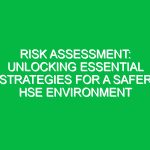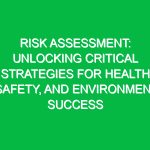Introduction
In the realm of Health, Safety, and Environment (HSE), the term “risk assessment risk” may seem paradoxical. However, it encapsulates a critical concept that plays a pivotal role in safeguarding individuals, communities, and ecosystems from preventable harm. Risk assessment risk refers to the uncertainties and potential failures associated with the process of identifying, evaluating, and managing risks within various operational contexts. Understanding and addressing these risks is vital for any organization committed to HSE success.
The importance of risk assessment risk cannot be overstated. In an era where industries are under constant scrutiny and regulatory compliance is paramount, the ability to accurately assess risks can mean the difference between a safe workplace and a catastrophic incident. For instance, consider the tragic events at the Deepwater Horizon oil spill in 2010. This disaster, which resulted in significant environmental damage and loss of life, was partly attributed to inadequate risk assessments and a lack of understanding of the risks involved in offshore drilling. Such examples underscore the necessity of recognizing and mitigating risk assessment risks as an integral part of HSE protocols.
Understanding Risk Assessment Risk in HSE
Risk assessment risk encompasses various dimensions that organizations must navigate to maintain safety and compliance. At its core, it involves the identification of hazards, evaluation of their potential impacts, and the implementation of appropriate control measures. However, as organizations delve into this process, they often encounter several key aspects that can complicate effective risk management.
The Complexity of Risk Identification
One of the foremost challenges in risk assessment risk is accurately identifying potential hazards. Hazards can arise from numerous sources, including physical environments, human behavior, and technological systems. Moreover, each hazard can manifest in various forms, making it crucial for organizations to adopt a comprehensive approach to hazard identification.
For example, in a manufacturing setting, risks may stem from machinery, chemicals, or even ergonomic issues related to repetitive tasks. Each of these hazards requires a tailored approach to risk assessment. Organizations must leverage tools such as Safety Data Sheets (SDS) for chemicals, conduct regular equipment inspections, and engage employees in discussions about safety practices to foster a proactive culture.
Evaluating Risks: The Challenge of Uncertainty
Once hazards are identified, the next step involves evaluating the associated risks. This process often introduces uncertainty, a central aspect of risk assessment risk. Organizations must grapple with factors such as the likelihood of an incident occurring and the severity of its potential consequences.
Quantitative and qualitative methods can aid in this evaluation. For instance, a quantitative approach might involve calculating the probability of equipment failure based on historical data, while a qualitative method could involve expert interviews or employee surveys. However, relying on historical data can lead to complacency, particularly if past incidents are viewed as isolated events. To combat this, organizations should continuously review and update their risk evaluations to reflect current conditions and emerging threats.
Implementing Control Measures: The Human Factor
After evaluating risks, the next step is to implement control measures designed to mitigate identified hazards. However, this is where risk assessment risk can often escalate. The effectiveness of control measures hinges not only on their design but also on employee buy-in and adherence. Simply put, if employees do not understand or prioritize safety protocols, even the most comprehensive risk management strategies can fail.
This human factor underscores the importance of training and communication in the HSE domain. Organizations must invest time and resources into educating employees about the rationale behind safety measures, fostering a culture of safety that encourages open dialogue about risks and best practices.
Best Practices for Managing Risk Assessment Risk
To effectively navigate risk assessment risk, organizations can adopt several best practices that enhance their HSE strategies.
1. Conduct Regular Training and Drills
Regular training sessions and emergency drills can prepare employees to respond effectively to potential hazards. These initiatives not only enhance awareness but also reinforce the importance of risk assessment processes.
2. Foster a Culture of Safety
Creating an organizational culture that prioritizes safety can significantly reduce risk assessment risk. By encouraging employees to voice concerns and participate in safety discussions, organizations can gain valuable insights into potential hazards that may not be evident through traditional assessments.
3. Utilize Technology for Real-Time Monitoring
Advancements in technology, such as IoT devices and AI analytics, offer organizations the ability to monitor risks in real-time. These tools can provide early warnings for potential hazards, enabling organizations to take preemptive action and reduce the likelihood of incidents.
4. Establish Clear Communication Channels
Effective communication is critical in risk management. Establishing clear channels for reporting hazards and discussing safety concerns can empower employees and encourage proactive engagement in risk assessment processes.
Regulations and Standards Impacting Risk Assessment Risk
Navigating the complex landscape of regulations and standards is another crucial aspect of managing risk assessment risk in the HSE domain. Various national and international bodies have established guidelines that organizations must adhere to, ensuring a consistent approach to risk management.
OSHA Standards
In the United States, the Occupational Safety and Health Administration (OSHA) imposes regulations requiring employers to assess workplace hazards and implement appropriate control measures. Failing to comply with these standards can result in significant penalties and increased risk to employee safety.
ISO 45001
On a global scale, ISO 45001 provides a framework for occupational health and safety management systems. This standard emphasizes the importance of risk assessment and encourages organizations to consider the context of their operations when evaluating risks. Aligning with ISO standards not only enhances compliance but also demonstrates a commitment to continuous improvement in HSE practices.
Real-Life Examples: Lessons Learned
Learning from real-life incidents can provide valuable insights into the implications of risk assessment risk. For instance, the 2013 Rana Plaza collapse in Bangladesh resulted in the tragic loss of over 1,100 lives. Investigations revealed that inadequate risk assessments regarding the structural integrity of the building played a significant role in the catastrophe. This incident serves as a stark reminder of the consequences of neglecting risk assessment processes and highlights the need for comprehensive evaluations in the construction industry.
Conclusion
In conclusion, risk assessment risk is a multifaceted concept that plays a vital role in the HSE domain. By understanding the complexities of risk identification, evaluation, and mitigation, organizations can enhance their safety protocols and foster a culture of proactive engagement in risk management.
The journey toward effective risk assessment is not without challenges, but by adopting best practices, adhering to regulations, and learning from past incidents, organizations can significantly reduce their risk exposure. Ultimately, prioritizing risk assessment risk not only protects individuals and the environment but also contributes to the sustainability and success of the organization in an increasingly safety-conscious world. As we move forward, it is essential for organizations to remain vigilant and committed to refining their risk assessment processes in the pursuit of HSE excellence.


